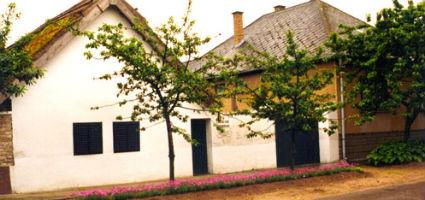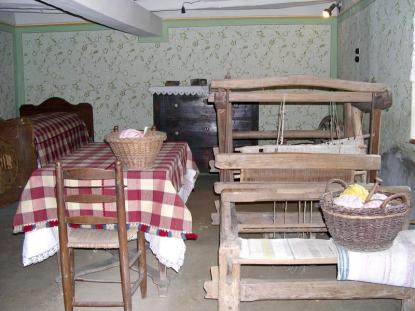2025. July 17. Thursday
Bunjevci Region House - Baja - Szentistván
 |
Address: 6500, Baja - Szentistván Pandúr utca 51.
Phone number: (79) 324-173
E-mail: bajaimuzeum@gmail.com
Opening hours: 01.04-31.10.: Wed-Sat 10-14
|
Hungary's 150-year-long occupation by the Ottomans, and the ensuing military campaigns lead by the Hapsburgs against the Turks, took their toll. The Hungarian population of Baja and its region declined to almost zero; many were killed, and most of the survivors fled. Although the 1699 Peace Treaty of Karlóca put and end to Turkish rule in Hungary, the Ottomans continued to control the Balkans. Fearing Turkish retaliation, the Christian peoples of the region fled to Hungary in masses, some of them settling down between the rivers Tisza and Danube, reclaiming the deserted and devastated parts of Bácska from their sad ruins. In 1686, a big group of Bunjevci (catholic Southern Slavs) followed their leaders Markovic and Vidakovic to the region, most of them settling in or around Baja, Szeged and Szabadka (today Subotica, Yugoslavia).
The Bunjevci arrived to Bácska from an area North of the Dalmatian shores in Bosnia-Herzegovina. Their ethnic name probably reflects the fact that they originate from the region of the river Buna. 17th century sources mention them as Dalmatians, but sometimes they are referred to as Catholic rác (Serbs) or Catholic Croats. In Baja, most of the Bunjevci lived and continue to live in the Southern part of the city called the Alvég, or "South End", and in Szentistván, a district in the Northern part of the city.
From the second half of the last century, the Bunjevci built the same type of houses as they did in the Hungarian Plain. The restored Bunyevác Tájház, or "Bunjevac House", is also a representative of this type of building. It consists of a kitchen, two bedrooms on each side of the kitchen, a stable and a pen. The walls are built from adobe building blocks; the roof is made of reeds.
The prednja soba or "first room" has two windows overlooking the street. The clothes cabinet, known as almar or sanduk, stands right between the two windows, with krevet, beds next to the walls, and with another cabinet, the sifonér next to the window overlooking the courtyard. Right in the middle of the room, we find the table, asztal with a few chairs, stolica. The pec, or oven, standing in the corner is of the type commonly used in Bácska. It is rectangular, ending in a cone. The oven, just like the walls of the house, are decorated with clichet painting. The door opening into the kitchen has a high threshold or prag. The most interesting feature of the kitchen is the open-fire or open-chimney fireplace. A cooking bench is built right in from of the hearth, which was the actual place of cooking.
A peculiarly colorful phenomenon of the houses of the Bunjevci is the abundance of home-woven wool blankets, bed covers and table covers. Bunjevci dye their own wool, which they also use to make aprons and bags. Bunjevac women, purchased commercial cotton yarn to weave the textiles for holiday linen articles, adorned shawls, bed linen and bodices called cancana and peškir.
Bunjevci enjoyed luxurious attires. They often wore garments made of expensive silk, velvet and brocade fabrics. During the turn of the century, women dressed much like the urban bourgeois. Their skirts were long enough to touch the ground; from the early 20th century, the skirts covered the ankles. Women wore several skute or underskirts. After the turn of the century, leather shoes became fashionable. Hungarian men also often wore silk or velvet vests adorned with silver buttons, another example of cross-cultural influence.
Bunjevci preserved their folk traditions until the early 20th century. When proposing to their future wives, they gave an apple to the chosen maiden; the apple was decorated with coins pierced into it. In return, the future bride gave the groom a handkerchief or a shirt that she made herself. When the wedding procession takes the bride to the site of the wedding festivities, men on horses surround the bride's carriage. This tradition goes back to the Ottoman period and is explained as a measure to prevent the kidnapping of the bride.
Bunjevci also have a wide range of folk customs related to church holidays. At Easter, when lads visit all the girls and "water" them so they may not "wilt", the girls express their gratitude for the attention by giving the lads apples, oranges or lemons died with wax and soot. Electing a kraljica or Pentecostal Queen was another long-lasting tradition among the Baja Bunjevci.
Bunjevci, even today, live in a very closely-knit society. Up to the first half of the 20th century, the predominant family structure was the cohabitation of three generations. They still keep family ties with both close and distant relatives. Social events are based on family units; the annual prelo is a come-together of young married women within the same extended family. Today, this event is not an active custom any more; however, Baja Bunjevci still hold a veliko prelo once a year, which is a major social event with music and dance where they sing Bunjevac folk songs and dance kolo or circle dances.
The various ethnic groups of the Baja region, who have lived together for hundreds of years, have not only become familiar with one another's culture, but also influenced each other. The rich diversity is still a predominant feature of Northern Bácska.
The Bunjevci arrived to Bácska from an area North of the Dalmatian shores in Bosnia-Herzegovina. Their ethnic name probably reflects the fact that they originate from the region of the river Buna. 17th century sources mention them as Dalmatians, but sometimes they are referred to as Catholic rác (Serbs) or Catholic Croats. In Baja, most of the Bunjevci lived and continue to live in the Southern part of the city called the Alvég, or "South End", and in Szentistván, a district in the Northern part of the city.
From the second half of the last century, the Bunjevci built the same type of houses as they did in the Hungarian Plain. The restored Bunyevác Tájház, or "Bunjevac House", is also a representative of this type of building. It consists of a kitchen, two bedrooms on each side of the kitchen, a stable and a pen. The walls are built from adobe building blocks; the roof is made of reeds.
The prednja soba or "first room" has two windows overlooking the street. The clothes cabinet, known as almar or sanduk, stands right between the two windows, with krevet, beds next to the walls, and with another cabinet, the sifonér next to the window overlooking the courtyard. Right in the middle of the room, we find the table, asztal with a few chairs, stolica. The pec, or oven, standing in the corner is of the type commonly used in Bácska. It is rectangular, ending in a cone. The oven, just like the walls of the house, are decorated with clichet painting. The door opening into the kitchen has a high threshold or prag. The most interesting feature of the kitchen is the open-fire or open-chimney fireplace. A cooking bench is built right in from of the hearth, which was the actual place of cooking.
A peculiarly colorful phenomenon of the houses of the Bunjevci is the abundance of home-woven wool blankets, bed covers and table covers. Bunjevci dye their own wool, which they also use to make aprons and bags. Bunjevac women, purchased commercial cotton yarn to weave the textiles for holiday linen articles, adorned shawls, bed linen and bodices called cancana and peškir.
Bunjevci enjoyed luxurious attires. They often wore garments made of expensive silk, velvet and brocade fabrics. During the turn of the century, women dressed much like the urban bourgeois. Their skirts were long enough to touch the ground; from the early 20th century, the skirts covered the ankles. Women wore several skute or underskirts. After the turn of the century, leather shoes became fashionable. Hungarian men also often wore silk or velvet vests adorned with silver buttons, another example of cross-cultural influence.
Bunjevci preserved their folk traditions until the early 20th century. When proposing to their future wives, they gave an apple to the chosen maiden; the apple was decorated with coins pierced into it. In return, the future bride gave the groom a handkerchief or a shirt that she made herself. When the wedding procession takes the bride to the site of the wedding festivities, men on horses surround the bride's carriage. This tradition goes back to the Ottoman period and is explained as a measure to prevent the kidnapping of the bride.
Bunjevci also have a wide range of folk customs related to church holidays. At Easter, when lads visit all the girls and "water" them so they may not "wilt", the girls express their gratitude for the attention by giving the lads apples, oranges or lemons died with wax and soot. Electing a kraljica or Pentecostal Queen was another long-lasting tradition among the Baja Bunjevci.
Bunjevci, even today, live in a very closely-knit society. Up to the first half of the 20th century, the predominant family structure was the cohabitation of three generations. They still keep family ties with both close and distant relatives. Social events are based on family units; the annual prelo is a come-together of young married women within the same extended family. Today, this event is not an active custom any more; however, Baja Bunjevci still hold a veliko prelo once a year, which is a major social event with music and dance where they sing Bunjevac folk songs and dance kolo or circle dances.
The various ethnic groups of the Baja region, who have lived together for hundreds of years, have not only become familiar with one another's culture, but also influenced each other. The rich diversity is still a predominant feature of Northern Bácska.
|
Permanent exhibitions
|
|
